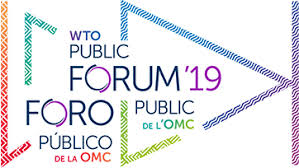New digital technologies: The protagonists of a change in perspective in the global supply chain
8 Oct 2019 02:00h
Event report
[Read more session reports from WTO Public Forum 2019]
Mr Luca Rinaldi (Vice-Chair, AIPPI Standing Committee on TRIPs) launched the session by considering how emerging technologies such as artificial intelligence (AI), Internet of Things (IoT), 3D printing, and blockchain are disrupting the trading system. Among the consequences, Rinaldi notes, are the ‘servicification’ of the global value chain (i.e. blurring the distinction between goods and services), the decentralisation of the current business models, and the mass ‘platformisation’ of a range of sectors (i.e. platforms have become the meeting venue for service providers and consumers). He concluded his address by stressing the aim of the session, namely, to demonstrate how the fourth industrial revolution can be harnessed to contribute to the achievement of the 2030 Agenda for Sustainable Development.
Mr Peter Green (Deputy Laboratory Director for Science and Technology and Chief Research Officer, National Renewable Energy Laboratory (NREL)) presented on the role of additive manufacturing, that is, 3D printing technology, in the production of renewable energy supplies. He considered that in the coming years, with an increasing population living in cities, electrification will represent a serious concern. NREL is already experimenting with the use of 3D printing technology to create electric grids which, powered by renewable resources, will contribute to powering the cities of the future. He also presented on other current applications of additive manufacturing, such as the production of a marine hydrokinetic (MHK) turbine and blades for wind turbines. Green considered that 3D printing represents the future of manufacturing, because it allows for the construction of many supplies on the construction site and uses materials that are lighter than traditional ones. Moreover, he considered that those regions of the world that have an advanced scientific infrastructure will have an advantage compared to other countries, because they will have the potential to create highly sophisticated 3D objects.
Mr Emmanuelle Ganne (Senior Analyst, WTO) addressed the benefits of blockchain to the trading system. Trade of goods is usually considered a labour- and paper-intensive sector. It has been estimated that during a trading process, around five thousand data interactions are generated, but only 1% of them actually create value. Introducing blockchain technology into this process entails a number of promises. It can make trade more transparent by improving traceability of products, and more efficient by allowing different actors to work on a peer-to-peer basis and monitor the supply chain process. More broadly, blockchain can also help to provide a proof of existence and ownership of goods, thanks to its time stamping function; and to fight piracy and counterfeiting through simplified management and enforcement of intellectual property (IP) rights. Ganne concluded her presentation by considering the existing challenges to the use of blockchain technology. On the operability side, it is still difficult to ensure that all the functions, the data, and the technology involved in the process are aligned. On the regulatory side, regulations need to be developed to ensure that technology can be used at its best potential.
Mr Guido Noto La Diega (Senior Lecturer in Intellectual Property Law and Cyber Law, Northumbria University School of Law) addressed whether AI and IoT technology can facilitate the achievement of the 2030 Agenda and be regulated by IP law. He first considered that AI can play a role vis-à-vis the sustainable development goals (SDGs) by addressing good health and well-being. For example, many applications of AI technology already support medical imagery screening and disease prevention. He then considered that the development of IoT devices will contribute to industrial innovation, since the service sector will be enhanced. However, as a consequence, the distinction between goods and services will become blurred, since goods have an increased number of embedded services and software. La Diega then focused on whether the existing IP framework can provide a governance structure for the latest technological developments. Artificial Intelligence will change the way we apply and understand pertinent law. We will pass from the figure of the ‘skilled practitioner in the relevant field of technology’ to an AI-enhanced researcher: a person who has to determine whether a new invention, with an additional, innovative component to the current state of the art, will enhance such research. He concluded by considering that IP law will play a limited role in governing AI and IoT; the opposite is expected: AI will drive and govern developments in law.
Mr Daniel J. Gervais (Professor of Law, Vanderbilt University Law School) addressed the challenges that AI and IoT pose to the existing legal system. On the one hand, such technologies are based on a decentralised structure; therefore, it is difficult for courts to establish a base for jurisdiction and to attribute a location to the creation of value (i.e. apply the relevant taxation laws). On the other hand, the existing legal framework has difficulties in dealing with subjects that are not human because it is often not possible to understand the decision-making process of the algorithm and thus attribute liability. This is clearer if we take the example of AI and the creation of artistic works: since such technology has the capacity to self-learn and change its initial governing code, questions arise concerning who will have ownership of a final work of art and who is responsible for the actions of a machine acting under the instructions of a self-modified code.
Related topics
Related event

